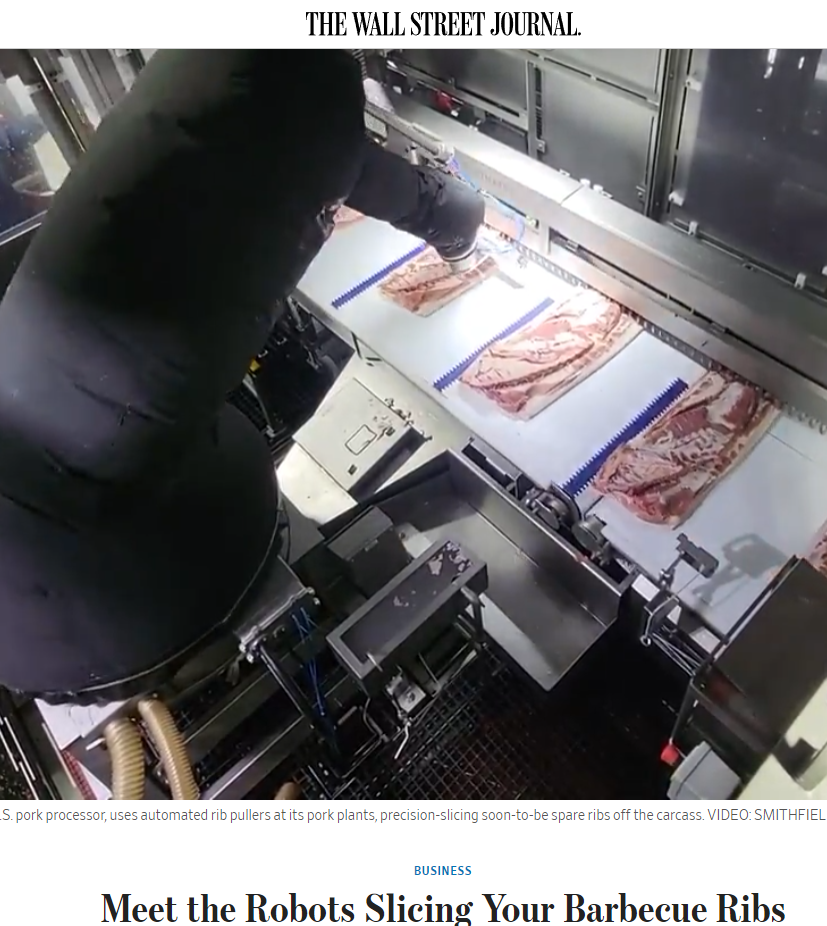Keller Watts, Chief Business Officer of Smithfield Foods said, “We can repurpose people” and that “It’s a key focal point for us.” Does anyone believe this? I understand why he has to say it, and they may “repurpose” those moved off the line to other positions, but we all know they will not be hiring new people to replace those “repurposed.”
Meatpackers are increasingly looking to robots for help. Smithfield, the largest U.S. pork processor, began rolling out automated rib pullers at its pork plants several years ago, which company officials said helps leave less wasted meat on the bone and relieves workers from some of the industry’s most physically demanding jobs—allowing workers to be reassigned from pulling loins or ribs to food-quality inspection jobs.
Keller Watts, chief business officer for Smithfield, said the company, which has roughly 35,000 employees in the U.S., aims to use automation to help reassign some 500 people a year. “We can repurpose people,” he said. “It’s a key focal point for us.”
The Wall Street Journal (free link)
What do we have to thank for this? The high cost of labor in the United States. What causes the high cost of labor? Government policies, labor unions, and a litigious society.
High minimum wages cause an increase in wages across the board. This is why unions fight to raise them. They know if the fast food employee down the street is making $20/hour then their entry level union member will have to be guaranteed a rate higher than that.
A $300 million, cutting-edge Tyson chicken processing plant that opened in late 2023 in Danville, Va., is designed to maximize efficiency. It can churn out 20% to 30% more chicken nuggets, strips and wings with 250 fewer people compared with an older, similar plant in Arkansas—part of the company’s $1.3 billion plan to automate more of its operations, from processing to packaging.
The Wall Street Journal (free link)
Government regulation causes higher labor costs due to compliance. Some of it is necessary safety regulations but a lot of it is nonsense. Back when I was in broadcasting there were mandated levels of employment of our small market FM radio stations. There was an FCC requirement that we have two full-time employees at each station. Even when a station was located in a rural area with very little revenue where we would lose money even having two employees at minimum wage let alone one “management” and one other full-time employee. There was also a requirement to comply with certain EEOC hiring processes if a station had more than five employees. The cost of compliance of adding that one additional employee meant we would have to hire two. One to do the job we needed and the other to handle the compliance paperwork. Naturally we stayed below the threshold as long as we could. It’s been 5 years since I left that field so I don’t know if those regulations remain. It’s just an example that I’m sure exists in other federally regulated industries.
Law suits contribute a great deal to the cost of labor. Employers carry tons of insurance to help them navigate the cost of a litigious employee. This is not to say some lawsuits are warranted but I would bet most are frivolous just to get a settlement out of the company. Sometimes laws are so lopsided towards the employee that even when the employee loses there are multiple avenues for appeal that keep cases alive for years.
In broadcasting we automated as much as we could. One more reliable automation system meant more than one less unreliable employee. Automations systems don’t complain. They don’t call in sick. And they won’t sue if they feel begrudged in the slightest.
I’m sure this is coming in a big way to California. A $20 minimum wage for fast food workers has to mean more robotic cooking machines and self-serve pick-up orders.
